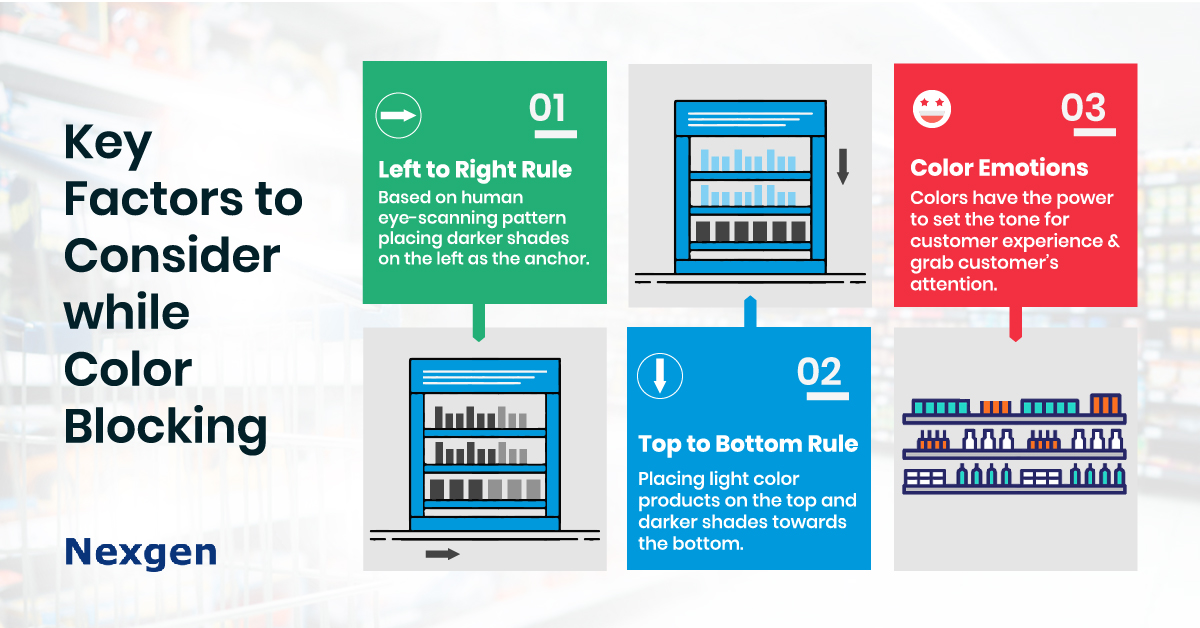For centuries artists have used color to convey and invoke emotions. From detailed researches to personal experiences have revealed the psychological impact of colors on human beings. Now, the effect of colors is taken advantage of in nearly all aspects of consumer life. Interior designers, web designers, advertisers, visual merchandisers are all using color as a powerful communication tool that can be used to influence mood, invoke emotions and stimulate reactions.
When you walk through a highway, appealing windows and the display of products in your store are the determining factors that can attract a potential customer to your store over your competitors. This process of attracting customers to your store using visually compelling displays and product arrangement is visual merchandising. Color is one of the key components of this visual selling strategy that helps physical stores strive and succeed with their online competitors.
Color Blocking
Color Blocking is the merchandising methodology that uses color coordination to improve the visual aesthetics of the product displays and encourage store walk-ins and sales. Though the perceptions of color are subjective, some color effects have universal meaning. For example, colors in red spectrum are known to evoke feelings of warmth, spicy and comfort whereas colors on the blue spectrum are known as smoothening or calm colors.
The same color psychology can be used to impact how people perceive products. Businesses are taking extra care in deciding the color for their logo and packages in such a way that they send the right subliminal messages to inspire the potential customers to buy their products.
Color Blocking - Factors to consider while planogramming
One of the important things to take note is color merchandising has to be done seasonal for optimal results.
For example, during Christmas season stores indulge in visual merchandising that involves mostly red green and white colors. During summer, people tend to prefer lighter colors over darker shades and vice versa during winter. It is a common sight that all the stores are bathed in red on Valentine’s day. So, it is highly important for the stores to incorporate seasonal color coding while color blocking.
Planograms help to design your color blocking strategies and get the right visual schematic before implementation.
Left to Right Rule
Another important factor to consider is the eye-scanning pattern. As people prefer dark colors during winter, placing products with darker shades on the left and lighter shades towards right side has found to yield better results. As the natural eye-scanning pattern is from left to right, the darker shades on the left act as the anchor to entice customers. During summer, the reverse order has found to yield better sales
Top to bottom rule
Color blocking rule for top to bottom rule is placing light color products on the top and darker shades towards the bottom. Unlike the left to right rule, top to bottom rule is usually followed round the year.

Color Emotions
We live and shop in a customer experience economy where the very idea of physical store has changed. Customers won’t necessarily buy from you just because you have a great product and a big store. Customer are looking for emotion connections and personalized experience. Colors have the power to set the tone for customer experience, grab customer’s attention and inspire different emotions.
Apart from the universal meaning, certain colors can evoke different meanings based on your store’s location, traditional values of that region and other factors. Choosing the right color for your merchandising can enable your store to stand out from the crowd than blending into it.
Use colors strategically and let your customers see what you want them to see and help them to perceive your store and products the way you aim to be perceived.
Color Blocking Using Nexgen POG
Nexgen POG is a robustious planogram builder that equips you to build your best merchandising strategies. It’s a web-based planogram software that is multi-device and multi-browser compatible. You can design and access your planogram from anywhere using Nexgen POG using your user id and password. You can create your planogram designs by dragging and dropping products from the product library to the appropriate shelf. Nexgen POG also has just click and post planogram compliance management feature that provides an easy and effective way to ensure shelf level compliance. The tickets allow you to attach a particular shelf and products that are out of compliance.
Nexgen POG also has a visual analysis feature that allows your planogram designs to be reviewed in different color schemes based on various modes like brand, manufacturer, size/UOM package etc. You can give your customized color codes in each mode. Nexgen POG also generates various analysis reports that allow you to gain insights into your sales patterns and customer behavior that decide on your color blocking and merchandising methodologies.
Get your free trial now. Try Nexgen POG for free.